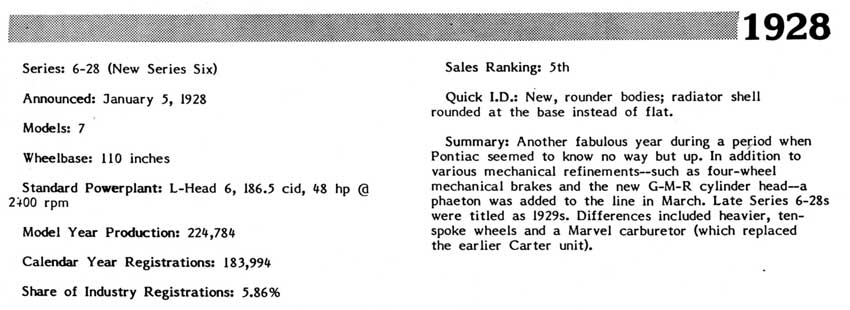
1928 Pontiac Series 6-28
I explained the rather confusing model designations in the March, 2008 issue when I covered the 1927 Pontiacs. This article will only cover Pontiac models designated Series 6-28, regardless of what the advertising department or the vehicle title says. The Series 6-28 automobiles entered production on December 7th, 1927 and were introduced to the buying public at the New York Auto Show in January, 1928. The initial 6-28 Series was produced through June of 1928 and approximately 130,000 automobiles were made.
The Series 6-28 featured all new Fisher bodies featuring a taller and narrower radiator shell, deeply crowned fenders and a style-line ran the full length of the body. The radiator cap depicted an Indian brave instead of the previous Indian chief. The models included a 2 door; 2 passenger coupe, model number 8250; a 2 door Sport coupe with rumble seat to accommodate 4 passengers, model number 8260. The familiar 2 door, 5 passenger sedan, listed as model 8240. This continued to be the most popular Pontiac model, sharing the same body style as the original Pontiac of 1926. There were also two 4 doors models, the 8820 standard sedan, formerly known as the Landau sedan; and the 8230 Sport sedan, which replaced the Deluxe Landau Sedan of the previous 6-27 Series.
Stewart continued to supply the 2 door, rumble seat roadster that first appeared in early 1927 and this was supplemented in March by a 4 door Sport Phaeton. The Stewart bodied Pontiacs were identified by ROAD and PHAE designations, not model numbers.
There were some significant mechanical changes for the Series 6-28 Pontiacs; most notable were 4 wheel brakes, the new Harrison cross-flow radiator and the introduction of the AC mechanical fuel pump. The new front wheel brakes were internal, expanding shoes while the rear brakes continued to be external, contracting bands. The cross-flow radiator utilized 3 tanks and minimized the loss of coolant when the vehicle was operated at high speed or load, and a new thermostat was also installed in the cooling system.
The AC division of General Motors developed a mechanically actuated, diaphragm fuel pump and filter unit to replace the vacuum tank fuel pumps previously installed by Pontiac. This was an industry “first” for Pontiac automobiles and much more practical than the vacuum type, which lacked the ability to continue delivering fuel on any long uphill road due to the total lack of engine vacuum at high load. There were additional changes to the fuel system including a larger Carter carburetor and manifold to match. The Pontiac six cylinder engine remained at its original displacement of 186 cubic inches, but was equipped with new GMR cylinder heads that featured convex, rather than concave shaped combustion chambers. The compression ratio was bumped from 4.8 to 4.9 and the rated horsepower increased to 48 @ 2,850 rpm. An Oakland type muffler was new for Pontiac this year A further improved dry disc clutch backed the more powerful engine. The torque tube axle used the same 4.18:1 ratio as previously fitted.
The new bodies rode on heavier frames and front axles with improved steering, plus 12 spoke wooden wheels as standard equipment. Steel disc wheels and a single side-mount spare continued to be offered as options. Newly optional for 1928 were wire-spoke wheels and also “six wheel equipment” in the form of dual side-mount spares.
Interior changes included a dashboard gas gauge; previous models utilized a direct reading gauge mounted right on the tank at the back of the car. Theft prevention was improved by the adoption of the Blossom Coincidental Lock, which secured both the ignition and the transmission when locked. The coupe and 2 door sedan continued to use ribbed Corduroy upholstery; the 4 door sedan, Sport coupe and Sport Landau sedan featured mohair upholstery and all open models were fitted with leather.
The improved Series 6-28 models, (introduced in June as 1929 models) went into production in July of ’28 and continued through November 3rd of 1928. The significant change, which also happened to be outwardly apparent, was the adoption of Jaxon 10 spoke wooden wheels. The axle ratio was changed from 4.18 to 4.36:1. Marvel carburetors were fitted for the first time, and would remain in use until the introduction of the straight eight in 1933. The dashboard featured the instruments grouped in a cluster on a metal trim panel.
In all, 224,784 Series 6-28 automobiles were produced in eleven months; Pontiac was clearly a success story! The advertising proclaimed it General Motors’ lowest price Six, a fact that was soon to be inaccurate. Chevrolet was set to introduce its “cast-iron wonder” for the ’29 model year, and although it was an overhead valve design; it lacked many of the features that made Pontiac’s L-head six such a durable and reliable engine.
The die was cast; Pontiac was firmly established as a proven value in automobiles “one step-up” from the lowest priced 4 cylinder cars. No other manufacturer could hope to compete with Pontiac’s value due to the fact that it shared many components with other General Motors’ products. The vast purchasing power of GM, plus its research and development facilities were also brought to bear in Pontiacs favor. It was the 5th in sales for 1928, a position it would hold 15 more times through 1953. Pontiac achieved 4th in sales for 1930 and was the 6th place in sales every remaining year, including 1954.
I explained the rather confusing model designations in the March, 2008 issue when I covered the 1927 Pontiacs. This article will only cover Pontiac models designated Series 6-28, regardless of what the advertising department or the vehicle title says. The Series 6-28 automobiles entered production on December 7th, 1927 and were introduced to the buying public at the New York Auto Show in January, 1928. The initial 6-28 Series was produced through June of 1928 and approximately 130,000 automobiles were made.
The Series 6-28 featured all new Fisher bodies featuring a taller and narrower radiator shell, deeply crowned fenders and a style-line ran the full length of the body. The radiator cap depicted an Indian brave instead of the previous Indian chief. The models included a 2 door; 2 passenger coupe, model number 8250; a 2 door Sport coupe with rumble seat to accommodate 4 passengers, model number 8260. The familiar 2 door, 5 passenger sedan, listed as model 8240. This continued to be the most popular Pontiac model, sharing the same body style as the original Pontiac of 1926. There were also two 4 doors models, the 8820 standard sedan, formerly known as the Landau sedan; and the 8230 Sport sedan, which replaced the Deluxe Landau Sedan of the previous 6-27 Series.
Stewart continued to supply the 2 door, rumble seat roadster that first appeared in early 1927 and this was supplemented in March by a 4 door Sport Phaeton. The Stewart bodied Pontiacs were identified by ROAD and PHAE designations, not model numbers.
There were some significant mechanical changes for the Series 6-28 Pontiacs; most notable were 4 wheel brakes, the new Harrison cross-flow radiator and the introduction of the AC mechanical fuel pump. The new front wheel brakes were internal, expanding shoes while the rear brakes continued to be external, contracting bands. The cross-flow radiator utilized 3 tanks and minimized the loss of coolant when the vehicle was operated at high speed or load, and a new thermostat was also installed in the cooling system.
The AC division of General Motors developed a mechanically actuated, diaphragm fuel pump and filter unit to replace the vacuum tank fuel pumps previously installed by Pontiac. This was an industry “first” for Pontiac automobiles and much more practical than the vacuum type, which lacked the ability to continue delivering fuel on any long uphill road due to the total lack of engine vacuum at high load. There were additional changes to the fuel system including a larger Carter carburetor and manifold to match. The Pontiac six cylinder engine remained at its original displacement of 186 cubic inches, but was equipped with new GMR cylinder heads that featured convex, rather than concave shaped combustion chambers. The compression ratio was bumped from 4.8 to 4.9 and the rated horsepower increased to 48 @ 2,850 rpm. An Oakland type muffler was new for Pontiac this year A further improved dry disc clutch backed the more powerful engine. The torque tube axle used the same 4.18:1 ratio as previously fitted.
The new bodies rode on heavier frames and front axles with improved steering, plus 12 spoke wooden wheels as standard equipment. Steel disc wheels and a single side-mount spare continued to be offered as options. Newly optional for 1928 were wire-spoke wheels and also “six wheel equipment” in the form of dual side-mount spares.
Interior changes included a dashboard gas gauge; previous models utilized a direct reading gauge mounted right on the tank at the back of the car. Theft prevention was improved by the adoption of the Blossom Coincidental Lock, which secured both the ignition and the transmission when locked. The coupe and 2 door sedan continued to use ribbed Corduroy upholstery; the 4 door sedan, Sport coupe and Sport Landau sedan featured mohair upholstery and all open models were fitted with leather.
The improved Series 6-28 models, (introduced in June as 1929 models) went into production in July of ’28 and continued through November 3rd of 1928. The significant change, which also happened to be outwardly apparent, was the adoption of Jaxon 10 spoke wooden wheels. The axle ratio was changed from 4.18 to 4.36:1. Marvel carburetors were fitted for the first time, and would remain in use until the introduction of the straight eight in 1933. The dashboard featured the instruments grouped in a cluster on a metal trim panel.
In all, 224,784 Series 6-28 automobiles were produced in eleven months; Pontiac was clearly a success story! The advertising proclaimed it General Motors’ lowest price Six, a fact that was soon to be inaccurate. Chevrolet was set to introduce its “cast-iron wonder” for the ’29 model year, and although it was an overhead valve design; it lacked many of the features that made Pontiac’s L-head six such a durable and reliable engine.
The die was cast; Pontiac was firmly established as a proven value in automobiles “one step-up” from the lowest priced 4 cylinder cars. No other manufacturer could hope to compete with Pontiac’s value due to the fact that it shared many components with other General Motors’ products. The vast purchasing power of GM, plus its research and development facilities were also brought to bear in Pontiacs favor. It was the 5th in sales for 1928, a position it would hold 15 more times through 1953. Pontiac achieved 4th in sales for 1930 and was the 6th place in sales every remaining year, including 1954.


From the Identification Guide, Pontiac 1926 - 1966 by Thomas E. Bosnall
1928 T1 Scout Car 1928 Dealer Bulletin page
Magazine Ad Links:
Cold Weather Performance Lowest Priced Six Greater Smoothness and Stamina Vividly Styled Cross flow Radiator
Magazine Ad Links:
Cold Weather Performance Lowest Priced Six Greater Smoothness and Stamina Vividly Styled Cross flow Radiator
